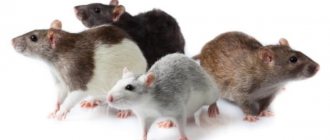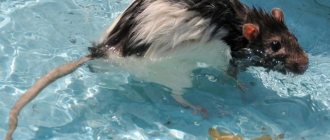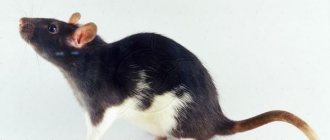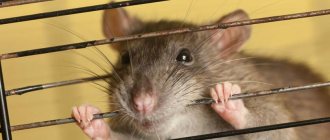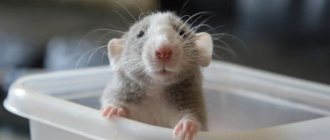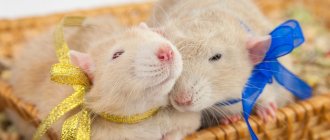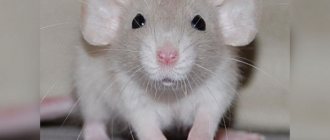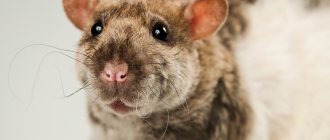One of the most popular pets among many children is the domestic rat. This is a very playful, funny pet that you will never get bored with. However, like any other animal, a rat requires special care, and even more so, feeding. These cute creatures are not whimsical. But there are nuances, which are: walking, huge cages, bathing or combing wool. The main rule is to take care of their proper balanced nutrition, thanks to which they will delight their owners with excellent health and unsurpassed appearance.
Basic principles of feeding
As for food portions, there should be moderation in everything. You should not overfeed a decorative rat, as this can lead to unnecessary excess weight. If your pet leaves a lot of food in the cage, you need to reduce the amount.
Try not to give your rat everything you eat yourself. There are specialized feeds that contain all the necessary components of plant and animal origin.
Considering that these animals are predominantly nocturnal inhabitants, they need the main portion of food in the evening. In general, they are provided with 2 meals a day - morning and evening.
Don't forget to include something hard in your diet so that your rats have the opportunity to wear down their growing teeth.
Owner reviews
CoeEkaterina
At the end of May we got ourselves a little friend - a decorative rat. They named him Stephen. He is a white, handsome boy with a bald tail. Initially, we did not have a cage; Stephen lived in a box. So, this is the worst idea. He happily gnawed at the box, ran away and traveled around the apartment. We bought a cage. Now he loves his house more than anything.
The cage cost about 600 rubles. It has three floors. We put the filler down, where the pet can safely perform its intimate affairs. The second floor used to be empty, but now there is something like a covered hammock hanging. The third floor is now empty. There used to be a house, but after a while the little rat began to get stuck in the house. I had to remove it.
We buy any food for rodents. Special sticks that rats love to chew. In addition to special food, we also give bread, meat (not raw), and fruit. In principle, rats are not picky eaters. With us, Steve eats everything he can see. Quite a calm animal. But we have a little rat coward. He is afraid to leave his house, if you let him go for a walk, for example, on the table, he will take a walk, but he is afraid to eat in the wild.
You shouldn't leave things near the cage; we successfully chewed two T-shirts and one book. We don't leave things around anymore. Even if it seems to you that the little thing is far away and he won’t reach it, then you are wrong. Somehow, miraculously, they will get everything through the bars :)
Teaching a rat some commands is quite difficult, but quite possible. We are now trying to rid the baby of fear. As I said above, she is afraid to be outside her home. Next we will teach some basic commands.
Is it worth buying a rat? If you don't like animals, don't buy. And of course, if you are too lazy to often change the litter, wash your pet and care for it, then not only should you not buy a rat, but any other animal too.
arth
I had both hamsters and mice. But I was drawn to heavier artillery.
I went to the nearest pet store and bought an ordinary white rat (female, about 5 months old). Classic, white fur, red eyes, pink paws and a tail barely covered with fur, I had to call her Lariska.
She put her in a small cage in which a hamster had previously lived, and soon went to buy a new one, the rat had no place to turn around! A couple of weeks later, I bought her a friend (who, by the way, is her sister), at first they fought and sorted things out in a very funny way, but then they became friends and began to sleep together and play, only sometimes they took food from each other.
And a couple of weeks later, the second rat gave birth to 11 baby rats, 10 alive and 1 dead! (I knew I was buying a pregnant one). And I was amazed at how good and responsible mothers rats are! She gathered everyone in a heap under her and fed them, washed and cleaned them, built a nest for them when she felt danger, and dragged each one to a new place. Very cute. The rat babies grew up very quickly, and I had to give them away, I kept one for myself, the little rat was born of the Dumbo breed.
bird777
My love for rats began with the very first black and white rat, Felix, whom I bought at the market as a little rat. He immediately captivated me because he didn’t bite at all; before I had rats, I had hamsters, and I came across very biting ones that were even impossible to tame.
Rats will not sit on your hands for a long time, they are twisted, they always need to move and run somewhere. That's why a cage needs a wheel. But preferably something completely metal, otherwise they will chew the plastic one, as happened with us.
Food: I bought wheat, corn, barley, peas, seeds, rye at the market where they sell food for domestic chickens, mixed everything, and I got the main food for rats. In the summer she brought them green grass. Be sure to bring twigs from trees all year round; they need something to chew on to wear down their teeth.
In general, they eat everything. It goes without saying that they cannot have any “human” food, especially fried or boiled food. But sometimes we still couldn’t resist pampering them with a cookie or a piece of bread. They also sometimes gave us bones from chicken legs; the rats simply adore them and eat almost the entire bone. They also like cucumbers, various fruits, and boiled eggs.
The main disadvantage of rats is their unpleasant odor. It was heard even from one little rat, and when I had 9 of them, I had to clean the cages every day. But in principle, it’s not difficult to just change the bedding in the cage every day, especially if you have 1-2 rats and you clean it every day, there won’t be an unpleasant smell in the house. At first I used sawdust. Then I tried hay, but the smell from the hay became simply hellish, I quickly abandoned this idea.
The best option turned out to be mixing wood cat litter with sawdust, as this will reduce the smell.
You can also bathe the rats, then they will smell even less. We simply filled the bathtub with water and let them swim. It is advisable to put something in the middle that the rats can climb on to rest and swim further. Everyone swam with pleasure. Then the wet ones are very funny, but when they dry, they become even fluffier and odorless. The main thing is to place a cage with wet rats, where there is no draft, and under no circumstances bathe them if it is cold in the house.
Video
Proper diet for pet rats
In order for your pet to enjoy its good mood and good health for a long time, it is necessary to adhere to the correct diet.
It should contain:
- All kinds of greens - lettuce, parsley, dill, plantain, clover, dandelion leaves, radishes, celery, as well as sprouts of oats, wheat and any other grains.
- Vegetables - boiled potatoes, cabbage, cucumber, turnips.
- Fruits – Introduce any fruit into your pet rat’s food. But you should be careful with citrus fruits, as they can cause allergic reactions.
- Berries are a favorite treat of rodents. Therefore, whatever is at hand is allowed.
- Quail eggs are considered especially healthy, but regular chicken eggs are also suitable.
- Meat. Boiled beef, chicken, pork or turkey will do. It should be given in small pieces.
- Nuts. You can buy everything except almonds. This is because it can cause an allergic reaction.
- Dairy products. These include cottage cheese, kefir, yogurt. Thanks to them, proper intestinal function is established due to lactobacilli and bifidobacteria. However, there are rats that are lactose intolerant. Therefore, you also need to be careful with fermented milk products. To begin, offer a small portion, for example, of cottage cheese, and observe the reaction. If everything is in order, feel free to include this product in your diet.
It is important to understand that greens, fruits and vegetables are the most useful because they contain the maximum amount of vitamins and other essential microelements.
You can also include food sold for cats or dogs in your diet. However, it must be premium. This food consists of animal proteins, therefore it is necessary for the normal growth and development of your pet, as well as to increase its immunity.
Your pet's main daily diet should consist of grains and nuts.
The rest of the above components should be used as an additive or treat.
Meat and protein complementary foods
In addition to grain and succulent food, white rats must eat animal food. After all, the lack of protein negatively affects the health of the animals. Adult animals are given this complementary food twice a week, and young animals – every other day.
As a source of protein, the following is added to the diet of white rats:
- boiled chicken and quail eggs;
- lean, heat-treated meat (rabbit, chicken, veal and turkey);
- boiled fish and seafood;
- insects (flour beetle larvae, grasshoppers, zoophobas and gammarus).
Important! To prevent a white rat from choking on the egg yolk, it is left liquid or mixed with plain water. Quail eggs can be given directly in the shell, so that the rodent can independently decide whether to clean them or eat them whole.
White rats are fed meat individually so that the animals do not fight among themselves. Otherwise, the entire portion will be eaten by the most agile and arrogant rodents, and the rest will remain hungry.
Treats for your pet
Like people, decorative rodents really enjoy their favorite treats. In addition, these cunning animals often manipulate their owners, sitting in front of a full bowl of food with a pitiful look, begging for all sorts of goodies.
However, you should be very careful, since all treats often bring a good mood to your animal, but in too large quantities they are harmful to its health.
You can easily purchase many ready-made treats at any pet store. It is best to choose ones that do not contain flavorings, dyes, as well as sugar and salt. Most rodents love nuts, seeds, various dried fruits, and corn flakes.
Sometimes you can pamper your pet with unsweetened cookies for diabetics, pieces of slightly dried bread, and a minimal amount of chocolate.
For some animals, their favorite treats are pasta, eggs, meat, sausage, in general, everything that you eat yourself. Again, sometimes you can give all this, but always in moderation and infrequently.
Nutrition of a decorative rat during illness
Unfortunately, decorative rats, like any other animals, can get sick for some reason. During this period, it is especially important to immediately adjust your diet. What you feed a healthy pet is not always suitable for an animal with a weakened immune system. There are products in nature that will help a rat cope with its illness faster without resorting to medications.
First you need to understand the disease itself. If this is an infection, then mustard, plums, banana, and eggplant can help the rodent. Raspberries, cranberries, garlic and onions are also good to cope with the disease.
If you notice a tumor anywhere on your pet, be sure to add broccoli to its diet. The vitamins found in this vegetable are also useful for the prevention of various neoplasms.
For arthritis, ginger and garlic will best help, but in this case, changing your animal’s diet alone cannot save you; be sure to seek help from a veterinarian so that he can prescribe the correct treatment.
What to feed rodents during pregnancy
If you are ready to reproduce these beautiful animals, then their body should be properly prepared in advance, and first of all, their nutrition should be adjusted. If your pet has gained excess weight, then get rid of barley, corn, and other foods that contain a lot of calories. Also, do not indulge in foods containing fiber, fats and carbohydrates.
During pregnancy, make sure that your decorative rat receives all the necessary vitamins and beneficial microelements. It is best to include fish and poultry in your diet. To provide the body with minerals, give slaked lime, shell rock and chalk.
Avoid foods such as grapes, cucumbers, liver, onions, lettuce, and eggs during this period.
What is the best food to choose?
Regarding the choice of food, there are many points that you definitely need to know about. First of all, it is worth saying that the choice should be made in favor of high-quality mixtures. The fact is that our domestic feed is inexpensive, but its composition is quite poor, and most of it contains oats. In this case, it is better to prepare the mixture yourself.
Also remember that you should not buy food in cardboard packages that are not airtight, especially if they are sold in specialized stores, for example, in a hypermarket.
If such packaging was stored next to powder or other household products, the rodent could easily become poisoned. You should purchase mixtures that are sold in sealed packages; of course, the best are imported feeds. The best foods include:
- Versel-Laga Rat Nature.
- Vitacraft Menu Vital.
- Beaphar Xtra Vital Rat or Care+ Rat Food.
- Vitapol Karma Premium.
- JR Farm Ratten-Schmaus.
In addition to the fact that there are feed mixtures on sale, you can also purchase granulated feeds, which have their own advantages. They are no different in composition, the only difference is in appearance, they are very similar to food for dogs and cats.
Fairly hard, homogeneous crackers. They will be indispensable in the case when a cunning pet chooses all the tastiest things from the food mixture and leaves the grain. But remember that the diet should contain rye, wheat, oats and barley.
Nutrition of newborn rats
Naturally, immediately after birth, little rat pups feed exclusively on mother's milk. Therefore, it is necessary, first of all, to take care of the mother’s correct diet. After about a month, your pets can be gradually transferred to regular, proper, nutritious food.
There are still cases when, for some reason, a mother cannot feed her baby, so there is no way to do without human help.
You can replace mother's milk with dog or goat milk. If this is not possible, then purchase ready-made mixtures at a pet store and feed the babies according to the scheme given in the instructions.
For the first half month of life, pups need to be fed every 2 hours throughout the day. After this period, the number of feedings should be reduced and done every 4 hours.
During the month, the baby can be gradually switched to adult food. First, introduce your pet to fruits and vegetables. Then add grains to your diet. Don't forget about fermented milk products, which will help normalize intestinal function.
What to exclude from your diet
We have already figured out what you can feed your rodents, but it is equally important to know which foods are strictly prohibited.
These include:
- raw meat and fish;
- food with all kinds of spices;
- fruit pits;
- raw vegetables;
- alcoholic and carbonated drinks;
- blue cheeses;
- too fatty dairy products;
- leaves of indoor flowers;
- citrus;
- sweets;
- salty food;
- unripe fruits;
- cucumbers, beets, spinach.
We hope this article helped you figure out how to properly feed decorative rats. Despite the fact that these animals are omnivores, you should not feed them just anything, as this can lead to serious health problems.
By adhering to simple rules regarding the diet of your pets, you will be able to admire for a long time how they grow and enjoy life.
Do not forget that the main component of the diet is grains and vegetables. However, for proper nutrition, animals also need animal proteins, fermented milk products, fruits and a variety of greens.
Milk and dairy products
Many white rats lack the enzyme that processes lactose. Because of this, they do not digest whole milk. This product causes severe bloating and upset in animals, so it is completely excluded from the diet of white rats.
Instead, rodents are given natural unsweetened sour milk with a fat content of less than 5%. White rats can eat cottage cheese, fermented baked milk, yogurt and acidophilus. They are given no more than 1 dessert spoon on days when the rodent does not receive protein food.
